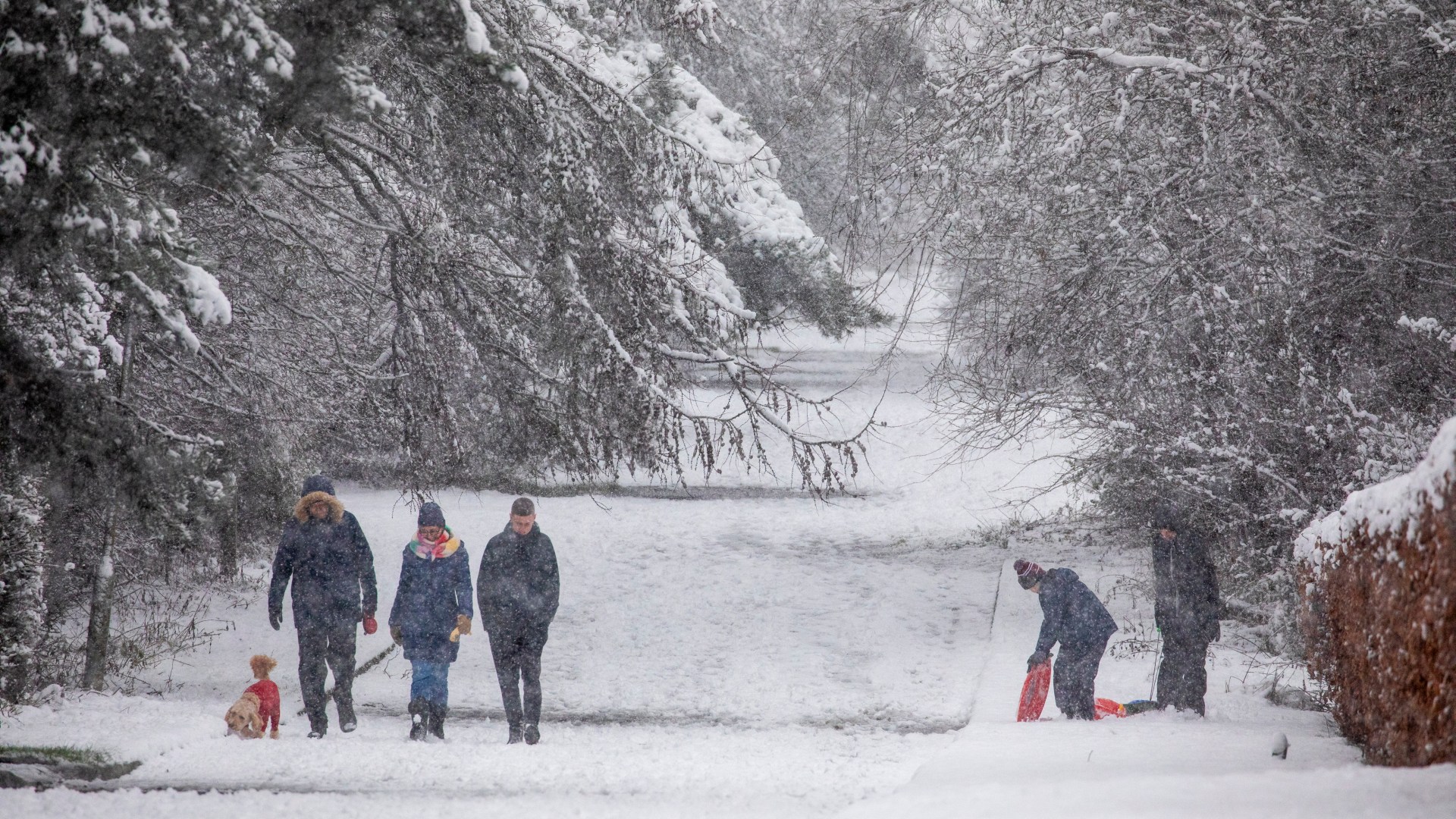WE’RE barely a few days into the New Year and the UK is already bracing itself for snow and plunging temperatures.
The Met Office issued a flurry of weather alerts for the weekend, warning of snow across the Midlands, Wales and northern England.
6

6
It also warned of rain and “strengthening winds” that could render travel difficult.
It comes after revellers braved gale force winds and torrential rain as they hit the streets to celebrate New Year’s.
Aside from affecting your mood or prompting you to wrap up warm, the weather can also taken affect on your health.
Studies show that people with chronic conditions like arthritis experience more pain during humid or windy weather.
Sadly it doesn’t stop with your joints, with different weather conditions triggering everything from migraines and asthma to heart attacks.
As the UK readies itself for snowfall, here’s what it and other types of forecasts could mean for your health.
The forecast: High winds
Your weather worries: Stress and migraines
When it’s blowing a gale outside, the body can react as if it is under attack and produce so-called fight or flight reflexes, such as raised heart rate and heightened emotions.
Meanwhile, windy conditions can trigger a migraine.
One reason is the effect on the hypothalamus, the area of the brain that monitors the body’s functions; it can lead to constriction or swelling of the blood vessels in the head which can cause the pain associated with migraine.
It can be difficult to prove that particular weather patterns trigger migraine attacks, but a few studies have sought to examine the phenomenon.
Scientists at the University of Calgary in Canada looked at the links between migraine sufferers having an attack and the occurrence of Canadian ‘Chinook’ winds – warm westerly winds specific to Alberta, Canada, which have a definite onset time and are an indicator of profound weather change.
Of 75 patients studied, 32 were more likely to have migraines during Chinook weather conditions than on days without them.
The American Migraine Foundation notes that a single trigger – like a a change in weather – may not be enough to prompt a migraine attack by itself.
Blustery winds or other weather patterns may only be able to trigger symptoms if a person is already prone to an attack due to fatigue, stress or lack of sleep, it said.
The forecast: Torrential rain
Your weather worries: Weight gain, E.coli and sore joints

6
A team from Aberdeen University found miserable, wet weather made it harder for dieters to shed weight.
They found those who were overweight had lower levels of vitamin D – which is created when the body is exposed to sunlight.
The amount of vitamin D in the blood influences the functioning of a hormone called leptin, which tells the brain when the stomach is full.
People who were obese produced a tenth less vitamin D than those of average weight.
And crops might well welcome the rain, but those living in rural areas won’t as it raises the risk of catching E.coli.
Farmers’ slurry contains E.coli O157 bacteria from cattle muck; heavy rain can wash the slurry into streams and form puddles; the bacteria can then be found in mud stuck to boots, or spread by pets.
War vets and anyone carrying significant scars won’t be relishing the rain either.
When outside pressure drops, it may cause normal tissue to expand and contract.
But because scar tissue isn’t elastic, but rather dense and rigid, it’s unable to adapt to the change in pressure, resulting in a pulling sensation that may lead to an aching pain.
And as the old wives claim, damp weather does seem to make joint pain and osteoarthritis worse.
While there is no conclusive evidence to explain this, it may be due to pressure receptors – called baroreceptors – in the joint sensing the drop in atmospheric pressure when the weather changes from dry to rainy.
The level of fluid in the joint then fluctuates in response to these changes, which might trigger pain in the nerves.
The forecast: Thunderstorms
Your weather worries: Headaches, asthma

6
The change in atmospheric pressure just before a thunderstorm often triggers headaches.
When the pressure drops, brain and nerve cells start interacting differently, causing head pain.
Many asthmatics also find their condition worsens if there’s a thunderstorm when pollen counts are high.
The gusty weather that precedes a storm can whisk up the pollen and fungal spores.
The air during thunderstorms is extra moist. This moisture can break pollen grains and fungal spores down into smaller pieces, which can get into your lungs and affect your breathing – potentially triggering an asthma attack.
This is often called thunderstorm asthma but it doesn’t affect everyone with the condition.
In June 2005, a six-fold rise in the number of emergency admissions for asthma in Britain was reported over one weekend as the result of thunderstorms.
“Thunderstorms move at tremendous speed and changes in air temperature cause cold air to sink, replacing warm air at ground level,” says Shuaib Nasser, a consultant in allergy and asthma at Cambridge University Hospitals NHS Foundation Trust.
“Unfortunately, this causes allergens such as pollen to be lifted off the ground, into the air and up to a level at which they can be inhaled into the lungs.”
The forecast: Scorching
Your weather worry: The blues
Hotter weather increases the risk of suicide, according to the British Institute of Psychiatry.
Researchers looked at 50,000 suicide cases in England and Wales over 10 years, and found a 3.8 per cent increase in suicide rates for every 1C rise in average temperature above 18C.
Someone might also be more likely to take their own life after consuming alcohol and this might be quite common when the weather is hot, suggests consultant psychiatrist Dr Jan Wise.
Subtle signs of a heart attack
A HEART attack is when the supply of the blood to the heart is suddenly blocked.
It is a medical emergency and needs to be treated right away.
Around 100,000 people are admitted to hospital due to heart attacks every year in the UK, according to the British Heart Foundation.
That’s 290 each day, or one every five minutes.
Some symptoms, like chest pain, shortness of breath and feeling lightheaded or dizzy, can be fairly obvious.
But the signs aren’t always so blatant, the NHS warns. Other more subtle symptoms of a heart attack include:
- Pain in other parts of the body (it can feel as if the pain is spreading from your chest to your arms, jaw, neck, back and stomach)
- Sweating
- Feeling sick
- Vomiting
- An overwhelming feeling of anxiety (similar to a panic attack)
- Weakness or fatigue
- Coughing
- Wheezing
A heart attack and cardiac arrest are similar, but not the same.
A cardiac arrest is when the heart stops pumping blood around the body.
The forecast: Brass monkeys
Your weather worry: Heart attacks, strokes, colds and flu

6
An estimated 20,000 people die each year in the UK as a result of strokes and heart attacks linked to a dramatic drop in temperature – it’s believed cold temperatures cause the arteries to narrow, restricting blood flow and reducing oxygen supply to the heart.
Cold weather also makes the heart work harder because more oxygen is needed to maintain body heat.
This could lead to a heart attack in vulnerable people such as the elderly.
German researchers also discovered that just five consecutive days of colder than average weather led to increased blood levels of two blood chemicals that can cause inflammation in the vascular system.
Subtle signs of a heart attack
A HEART attack is when the supply of the blood to the heart is suddenly blocked.
It is a medical emergency and needs to be treated right away.
Around 100,000 people are admitted to hospital due to heart attacks every year in the UK, according to the British Heart Foundation.
That’s 290 each day, or one every five minutes.
Some symptoms, like chest pain, shortness of breath and feeling lightheaded or dizzy, can be fairly obvious.
But the signs aren’t always so blatant, the NHS warns. Other more subtle symptoms of a heart attack include:
- Pain in other parts of the body (it can feel as if the pain is spreading from your chest to your arms, jaw, neck, back and stomach)
- Sweating
- Feeling sick
- Vomiting
- An overwhelming feeling of anxiety (similar to a panic attack)
- Weakness or fatigue
- Coughing
- Wheezing
A heart attack and cardiac arrest are similar, but not the same.
A cardiac arrest is when the heart stops pumping blood around the body.
Stroke is also more likely to happen, according to a report by John Moore’s University, Liverpool, because blood thickens in cold weather, increasing the risk of coronary and cerebral thrombosis.
And we get colds more in the winter because the cooling of the nose causes a slowdown of the infection-fighting cells in it, according to research from The Common Cold Centre at Cardiff University.
Cold also slows down the tiny hairs which normally sweep away viruses in mucus, it says.
Scientists at the US National Institute of Health believe that flu viruses tend to strike in cold weather, because during low temperatures a hard rubbery coating forms around the virus, giving it the protection it needs to pass from person to person.
This coating melts in the higher temperatures of the respiratory tract, allowing the virus to infect cells.
The forecast: High humidity/sticky
Your weather worries: Ear infections and gout
Outer ear infection – or otitis – becomes more common when humidity is high, as the ear canal is more likely to get damp.
This creates the perfect warm and moist environment for bacteria to flourish.
Otitis is an inflammation of the skin lining the ear canal and can cause itching and discharge.
Research at Nahdha Hospital in Oman found that people living in areas with high humidity were twice as likely to have problems with ear wax because of these bacteria.
Attacks of gout are more frequent on days of high humidity, possibly because of the effects of dehydration, a Boston University study found.
The forecast: Not a cloud in the sky
Your weather worries: Skin ageing and cancer
We should all know by now the dangers of sitting in the sun without any UV protection.
Most skin cancers are caused by too much exposure to ultraviolet (UV) light – an invisible kind of radiation that comes from the sun, tanning beds, and sunlamps.
This can damage the DNA in your skin, causing cells to grow out of control and leading to skin cancer.
But sun damage doesn’t only occur on hot, sunny days – it’s also possible for this occur on overcast days too, warns Cancer Research UK.
Though baking in the sun can be detrimental to your health, a burst of rays may also help protect against other cancers, scientists suggest.
A study by the Institute for Cancer Research in Oslo examined what happened to people diagnosed with cancer, and found that the risk of dying within three years of diagnosis with prostate, breast, colon or lung cancer, or with Hodgkin’s lymphoma, was up to 50 per cent lower for those diagnosed during summer and autumn compared with winter.
One explanation could be that vitamin D can help stop the growth of tumours.

6




